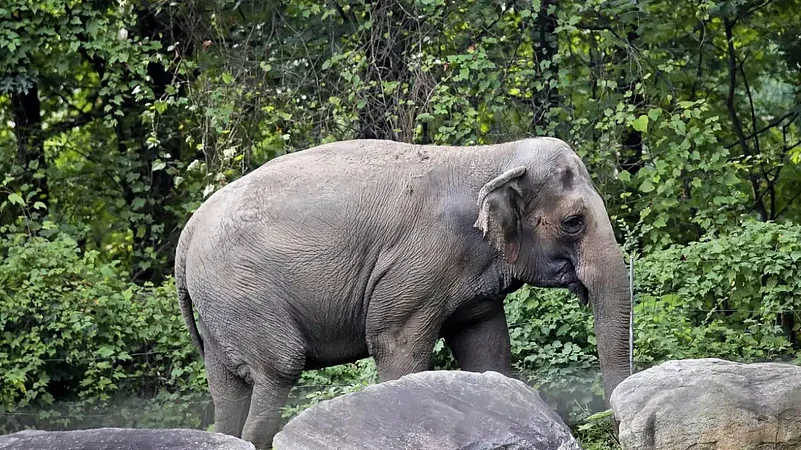On October 22, 2021, when a herd of 23 wild elephants ventured into the dense forests of Gadchiroli district in Maharashtra, the state’s forest department was a worried lot.
Wild elephants had come to Gadchiroli after 56 years and people living in the Vidharba belt had never seen elephants before. Forest officials had felt that since the villagers did not understand elephant behaviour, instances of elephant-human conflicts would be high. However, constant monitoring and sustained awareness campaigns for the villagers have helped to an extent, say forest officials.
This herd of about 23 elephants entered Gadchiroli, a district affected by the Naxalite movement. Major parts of the district come under the ‘red zone’ where people are prohibited to venture into due to the presence of the Naxals. This herd came into the Murumgaon and Dhanora ranges in Gadchiroli. According to wildlife experts, this herd had wandered from Odisha to Chhattisgarh and then entered Maharashtra.
The Forest Department of Maharashtra has collaborated with the West Bengal-based Stripes And Green Earth Foundation (SAGE) to constantly monitor this herd and work out an action plan that addresses any potential elephant-human conflict. The herd is constantly tracked using thermal drones, said Sagnik Sengupta, wildlife expert and founder of SAGE, to Outlook.
After a five-month stay in the dense forests of Gadchiroli, these wild elephants went back to Chhattisgarh on March 16, 2022. However, on August 13, 2022, they returned to the Gadchiroli forests. They kept moving and reached up to Bhandara district, about 123 kms away from Gadchiroli.
As they progressed towards Bhandara, forest officials and volunteers from SAGE pushed them back towards Gondhia, another densely forested district of Maharashtra. According to Sengupta, there is another group of about 35 wild elephants living in the Chhattisgarh forests, which could be a part of this herd.
“A single elephant needs 150 kgs of fodder and 120 litres of water per day. When their habitats shrink, they break up into smaller herds. Probably, the mining activities in Chhattisgarh pushed this herd towards Maharashtra,” said Sengupta.
However, their presence in this belt has not been without human casualties. Last year saw two human casualties — one at Chutiya village located at the border of the Nawegaon National Park and another at the Malewada range in Gadchiroli district. In the first case which took place on October 3, 2022, as the herd from Chhattisgarh progressed to other parts within Gadchiroli, they passed through the Chutiya village. Chased away by people, a 23-year-old sub-adult tusker, which was a little away from this herd, came from the side and attacked a person who died.
In the second case which took place on November 3, 2022, the same herd of elephants attacked a village in the Malewada range at night.
“The elephants are attracted to the mauwa flowers that are found in abundance in the forests. The villagers collect the flowers and make liquor and other preparations from them. The elephants were attracted to the village due to the smell of the mauwa flowers,” said Sengupta.
While the villagers ran out of their houses away from the advancing herd, an old man who was partially blind was left behind in his house. “He lit a torchlight. The elephants saw this light, attacked, and killed him,” said Sengupta.
In September 2022, villagers in Purkheda village in Gadchiroli district had climbed trees to look at the elephants that had come to the village.
“Elephants are not a regular feature here and the villagers had never seen elephants in these parts. They made noises sitting on the trees. The elephants attacked a tree on which people were sitting,” narrated Sengupta. People were injured but there were no deaths in this attack.
According to Sengupta, the elephants have been driven out of Chhatisgarh due to mining activities in the forests there and the shrinking of elephant habitats in the state. The blocking of their migratory route from the construction of two water canals by the Odisha government is also a reason for these elephants relocating to Chhattisgarh from Odisha. These canals, built after 2014, along the Odisha-Chhattisgarh and Odisha-West Bengal borders have blocked the route the elephants used to move back and forth. Wildlife experts believe that this herd may have been originally from Odisha, but due to their migratory route being blocked by the water canals, they relocated to Mahasamandh in Chhattisgarh.
This herd has a crop-raiding nature, said Sengupta. “They do not eat the crops but damage it by walking through or lying down on it,” he said. According to the study by SAGE and the forest officials, this herd is part of another larger herd of 35 wild elephants which are still living in Chhattisgarh. This is the reason for them going back to Chhattisgarh on March 16, 2022.
“The day the other herd living in Chhattisgarh joins this herd in Gadchiroli, they will not go back and will be permanent residents in Maharashtra,” said Sengupta. The forest officials and SAGE are jointly working on a five-year mitigation plan to ensure that there is no elephant-human conflict in this region. Vidharba, which is known for its tiger population, will now also have elephants in its forests.
The conflict mitigation measures undertaken by the Forest Department include regular tracking of the elephants, making water holes and fodder plots, construction of elephant-proof trenches, and solar fences. In Kolhapur and Sindhudurg districts, barriers are constructed between Maharashtra and Karnataka at the Reserve Forest and district boundaries.
“Our volunteers have sensitised the villagers living in areas close to the forests where the herd is located to the behavioral pattern of wild elephants. The wild elephants are new to these parts and villagers have never seen them before,” said Sengupta “We have taught the villagers how to drive away the elephants using a special kind of flambeau.”
According to a research paper by Prachi Mehta and Jayant Kulkarni titled Past, present and future of wild elephants in Maharashtra, wild elephants started extending their range into the state from 2002 onwards from adjoining Karnataka. Then, three groups of elephants, totaling 11, started living in the forests of Kolhapur and Sindhudurg districts of Maharashtra. A study done in 2013 found that Maharashtra did not have resident wild Asian elephants and that their presence was sporadic.
Going back in history, a 17th century Maharashtra gazetteer mentions that elephants were present in Nandurbar and Dhule districts in north-west Maharashtra. It is said that in 1940, the ruler of Kolhapur had brought in some wild elephants from the Radhanagari Wildlife Sanctuary in Karnataka into Kolhapur. However, these elephants went back to Karnataka. Mehta and Kulkarni’s research states that in 1956, a tusker which had ventured into the Amboli forest in Kolhapur from the North Kanara district of Karnataka was killed.
Sugarcane is the prime target of the herd of wild elephants living in the forests of Kolhapur. Other crops such as banana and paddy are also destroyed by elephants but these are in lower degrees than the destruction of the sugarcane crop. The crop-raiding by elephants in Kolhapur takes place from January to May and November and December. The peak month of crop-raiding is February. Wild elephants moving in Kolhapur do not damage crops between June and October, indicated the research by Mehta and Kulkarni. In the neighbouring Sidhudurg district, cases of crop raiding of non-cereal crops is higher than the cereal crops during most months.
For now, as these migratory animals find their way through the dense, undisturbed forests in the eastern belt of Maharashtra, the forest officials can only hope for passage without any conflict between the elephants and human in the habitats they pass through.


























